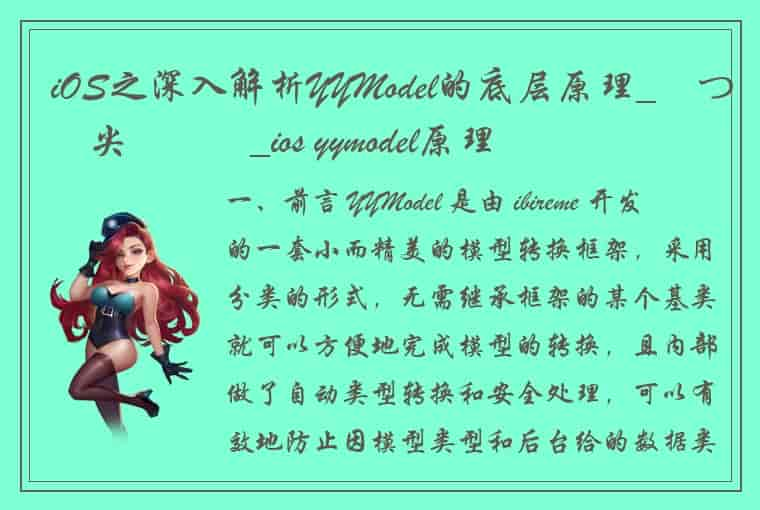组件化
本文主要介绍iOS组件化的三种方案
1、常?的三种方案 URL SchemeTarget - ActionProtocol - Class 匹配 1.1、?URL Scheme路由 使 URL 处理本地的跳转通过中间层进?注册 & 调? (load方法里把被调用者注册到中间层)注册表?需使用反射非懒加载 / 注册表的维护 / 参数URL Scheme路由示例?
//MTMediator.h --- start typedef void(^MTMediatorProcessBlock)(NSDictionary *params); + (void)registerScheme:(NSString *)scheme processBlock:(MTMediatorProcessBlock)processBlock; + (void)openUrl:(NSString *)url params:(NSDictionary *)params; //MTMediator.h --- end //MTMediator.m --- start + (NSMutableDictionary *)mediatorCache{ static NSMutableDictionary *cacheScheme; static dispatch_once_t onceToken; dispatch_once(&onceToken, ^{ cacheScheme = @{}.mutableCopy; }); return cacheScheme; } + (void)registerScheme:(NSString *)scheme processBlock:(MTMediatorProcessBlock)processBlock{ if (scheme.length > 0 && processBlock) { [[[self class] mediatorCache] setObject:processBlock forKey:scheme]; } } + (void)openUrl:(NSString *)url params:(NSDictionary *)params{ MTMediatorProcessBlock block = [[[self class] mediatorCache] objectForKey:url]; if (block) { block(params); } } //MTMediator.m --- end //注册 --- start + (void)load { [MTMediator registerScheme:@"detail://" processBlock:^(NSDictionary * _Nonnull params) { NSString *url = (NSString *)[params objectForKey:@"url"]; UINavigationController *navigationController = (UINavigationController *)[params objectForKey:@"controller"]; MTDetailViewController *controller = [[MTDetailViewController alloc] initWithUrlString:url]; // controller.title = [NSString stringWithFormat:@"%@", @(indexPath.row)]; [navigationController pushViewController:controller animated:YES]; }]; } //注册 --- end //调用 --- start //URL Scheme [MTMediator openUrl:@"detail://" params:@{@"url":item.articleUrl,@"controller":self.navigationController}]; //调用 --- end 复制代码 参考了系统URL Scheme机制参数传递通过dictionary,对调用者不透明目前iOS上大部分路由工具都是基于URL 进行匹配的,或者命名约定,通过runtime方法进行动态调用
优点:实现简单
缺点:需要维护字符串表,依赖于命名约定,无法在编译时暴露出所有问题,需要在运行时才能发现错误。
MGJRouterURL路由方式主要是以蘑菇街为代表的的MGJRouter
实现原理:
App启动时实例化各组件模块,然后这些组件向ModuleManager注册Url,有些时候不需要实例化,使用class注册当组件A需要调用组件B时,向ModuleManager传递URL,参数跟随URL以GET方式传递,类似openURL。然后由ModuleManager负责调度组件B,最后完成任务。 // 1、注册某个URL MGJRouter.registerURLPattern("app://home") { (info) in print("info: (info)") } //2、调用路由 MGJRouter.openURL("app://home") 复制代码URL 路由的优点
极高的动态性,适合经常开展运营活动的app方便地统一管理多平台的路由规则易于适配URL Scheme,可以下发URl 路由的缺点
传参方式有限,并且无法利用编译器进行参数类型检查,因此所有的参数都是通过字符串转换而来只适用于界面模块,不适用于通用模块参数的格式不明确,是个灵活的 dictionary,也需要有个地方可以查参数格式。不支持storyboard依赖于字符串硬编码,难以管理,蘑菇街做了个后台专门管理。无法保证所使用的的模块一定存在解耦能力有限,url 的”注册”、”实现”、”使用”必须用相同的字符规则,一旦任何一方做出修改都会导致其他方的代码失效,并且重构难度大 1.2、Target - Action 抽离业务逻辑通过中间层进行调?中间层使? runtime 反射中间层代码优化Target - Action示例?
//MTMediator.h #import <UIKit/UIKit.h> #import <Foundation/Foundation.h> NS_ASSUME_NONNULL_BEGIN @interface MTMediator : NSObject //target action + ( __kindof UIViewController *)detailViewControllerWithUrl:(NSString *)detailUrl; @end NS_ASSUME_NONNULL_END //MTMediator.m #import "MTMediator.h" @implementation MTMediator + ( __kindof UIViewController *)detailViewControllerWithUrl:(NSString *)detailUrl{ Class detailVC = NSClassFromString(@"MTDetailViewController"); UIViewController *controller = [[detailVC alloc] performSelector:NSSelectorFromString(@"initWithUrlString:") withObject:detailUrl]; return controller; } @end //调用 //Target - Action UIViewController *vc = [MTMediator detailViewControllerWithUrl:item.articleUrl]; vc.title = @"详情啊"; [self.navigationController pushViewController:vc animated:YES]; 复制代码 硬编码方式(直接调用,不利于维护和扩展)perform 最多能传递2个参数,可以传入字典避免参数过多initWithUrlString:方法必须实现 否则找不到sel崩溃业务逻辑柔合在Mediator中,可以各个模块写各自的MTMediator扩展 CTMediator原理是通过oc的runtime、category特性动态获取模块,例如通过NSClassFromString获取类并创建实例,通过performSelector + NSInvocation动态调用方法。
实现原理:
1、利用分类为路由添加新接口,在接口中通过字符串获取对应的类2、通过runtime创建实例,动态调用实例的方法CTMediator使用
//******* 1、分类定义新接口 extension CTMediator{ @objc func A_showHome()->UIViewController?{ //在swift中使用时,需要传入对应项目的target名称,否则会找不到视图控制器 let params = [ kCTMediatorParamsKeySwiftTargetModuleName: "CJLBase_Example" ] //CTMediator提供的performTarget:action:params:shouldCacheTarget:方法 通过传入name,找到对应的targer和action if let vc = self.performTarget("A", action: "Extension_HomeViewController", params: params, shouldCacheTarget: false) as? UIViewController{ return vc } return nil } } //******* 2、模块提供者提供target-action的调用方式(对外需要加上public关键字) class Target_A: NSObject { @objc func Action_Extension_HomeViewController(_ params: [String: Any])->UIViewController{ let home = HomeViewController() return home } } //******* 3、使用 if let vc = CTMediator.sharedInstance().A_showHome() { self.navigationController?.pushViewController(vc, animated: true) } 复制代码模块间的关系:
模块A——Mediator——target——模块B
优点
1、利用接口调用,实现了参数传递时的类型安全2、直接使用模块的protocol接口,无需再重复封装缺点
1、用框架来创建所有对象,创建方式不同,即不支持外部传入参数2、用OC runtime创建对象,不支持swift3、只做了protocol?和?class?的匹配,不支持更复杂的创建方式 和依赖注入4、无法保证所使用的protocol 一定存在对应的模块,也无法直接判断某个protocol是否能用于获取模块 1.2、Protocol - Class 增加 Protocol Wrapper层 (中间件先注册Protocol和Class对应关系,将protocol和对应的类进行字典匹配)中间件返回 Protocol 对应的 Class,然后动态创建实例解决硬编码的问题Protocol - Class示例
//具体的Protocol //MTMediator.h --- start @protocol MTDetailViewControllerProtocol <NSObject> + (__kindof UIViewController *)detailViewControllerWithUrl:(NSString *)detailUrl; @end @interface MTMediator : NSObject + (void)registerProtol:(Protocol *)protocol class:(Class)cls; + (Class)classForProtocol:(Protocol *)protocol; @end //MTMediator.h --- end //MTMediator.m --- start + (void)registerProtol:(Protocol *)protocol class:(Class)cls{ if (protocol && cls) { [[[self class] mediatorCache] setObject:cls forKey:NSStringFromProtocol(protocol)]; } } + (Class)classForProtocol:(Protocol *)protocol{ return [[[self class] mediatorCache] objectForKey:NSStringFromProtocol(protocol)]; } //MTMediator.m --- end //被调用 //MTDetailViewController.h --- start @protocol MTDetailViewControllerProtocol; @interface MTDetailViewController : UIViewController<MTDetailViewControllerProtocol> @end //MTDetailViewController.h --- end //MTDetailViewController.m --- start + (void)load { [MTMediator registerProtol: @protocol(MTDetailViewControllerProtocol) class:[self class]]; } #pragma mark - MTDetailViewControllerProtocol + ( __kindof UIViewController *)detailViewControllerWithUrl:(NSString *)detailUrl{ return [[MTDetailViewController alloc]initWithUrlString:detailUrl]; } //MTDetailViewController.m --- end //调用 Class cls = [MTMediator classForProtocol: @protocol(MTDetailViewControllerProtocol)]; if ([cls respondsToSelector: @selector(detailViewControllerWithUrl:)]) { [self.navigationController pushViewController:[cls detailViewControllerWithUrl:item.articleUrl] animated:YES]; } 复制代码 被调用者先在中间件注册Protocol和Class对应关系,对外只暴漏Protocol BeeHiveprotocol比较典型的三方框架就是阿里的BeeHive。BeeHive借鉴了Spring Service、Apache DSO的架构理念,采用AOP+扩展App生命周期API形式,将业务功能、基础功能模块以模块方式以解决大型应用中的复杂问题,并让模块之间以Service形式调用,将复杂问题切分,以AOP方式模块化服务。
BeeHive 核心思想
1、各个模块间调用从直接调用对应模块,变成调用Service的形式,避免了直接依赖。2、App生命周期的分发,将耦合在AppDelegate中逻辑拆分,每个模块以微应用的形式独立存在。示例如下:
//******** 1、注册 [[BeeHive shareInstance] registerService:@protocol(HomeServiceProtocol) service:[BHViewController class]]; //******** 2、使用 #import "BHService.h" id< HomeServiceProtocol > homeVc = [[BeeHive shareInstance] createService:@protocol(HomeServiceProtocol)]; 复制代码优点
1、利用接口调用,实现了参数传递时的类型安全2、直接使用模块的protocol接口,无需再重复封装缺点
1、用框架来创建所有对象,创建方式不同,即不支持外部传入参数2、用OC runtime创建对象,不支持swift3、只做了protocol?和?class?的匹配,不支持更复杂的创建方式 和依赖注入4、无法保证所使用的protocol 一定存在对应的模块,也无法直接判断某个protocol是否能用于获取模块建议:URL Scheme - handler 配合 Protocol - Class 使用 ?
附带:iOS组件化方案架构设计图
???????
?
 1.本站遵循行业规范,任何转载的稿件都会明确标注作者和来源;2.本站的原创文章,会注明原创字样,如未注明都非原创,如有侵权请联系删除!;3.作者投稿可能会经我们编辑修改或补充;4.本站不提供任何储存功能只提供收集或者投稿人的网盘链接。 1.本站遵循行业规范,任何转载的稿件都会明确标注作者和来源;2.本站的原创文章,会注明原创字样,如未注明都非原创,如有侵权请联系删除!;3.作者投稿可能会经我们编辑修改或补充;4.本站不提供任何储存功能只提供收集或者投稿人的网盘链接。 |
标签: #iOS #组件化 #url #SchemeTarget #ActionProtocol




